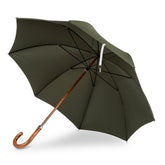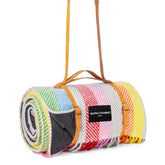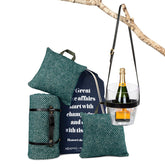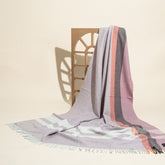How to Plan a Picnic for a Large Group: Step-by-Step Guide
Planning a picnic for a large group? Whether it's a company outing, family reunion, or a summer gathering with friends, organising a group picnic takes more than just sandwiches and sunshine.
In this guide, you’ll find step-by-step tips for planning a successful large picnic — from choosing the right location and menu to setting up, packing essentials, and adding fun extras like picnic blankets and champagne buckets to make it memorable.
Quick Summary
-
This guide covers how to plan a picnic for large groups of friends, family, or colleagues
-
Includes tips on location, food, setup, activities, and weather backups
-
Highlights essential picnic accessories like wool blankets, champagne buckets and umbrellas
Step 1: Choose a Date and Get RSVPs
The first and most important step when planning a group picnic is to start early. You’ll want to pick a date well in advance, ideally considering weather patterns, public holidays, and your guests' availability. If you’re organising a company or community event, it's especially important to avoid clashes with other calendar commitments.
Once you’ve chosen a date, send out invitations and ask guests to RSVP. This can be as simple as a WhatsApp group, email, or online invitation form. Knowing how many people are attending will help you plan everything else — from how much food and drink to buy to how many picnic blankets and tables to bring.
Creating a basic checklist or timeline can also help keep your planning on track. Set deadlines for booking locations, shopping, food prep, and reminders to your guest list.

Step 2: Pick the Perfect Picnic Location
Your picnic location can make or break the experience — especially for a large group. Look for a space that offers plenty of room to spread out, easy access, and the right facilities. Parks, beaches, private gardens, or countryside estates all have potential depending on your group size and the kind of event you're hosting.
When evaluating potential spots, consider:
-
Size – Enough space for people to sit, eat, and play games
-
Access – Is there parking, public transport, and wheelchair access?
-
Facilities – Are there toilets, drinking water, BBQ stations, or bins?
-
Shade or shelter – Essential for hot weather or the occasional British downpour
Also check whether the space requires a permit for large gatherings, especially if you're organising a company event or using speakers, tents, or catering.
When it comes to keeping people dry or stylishly shaded, British umbrellas are a smart picnic-day companion. Choose a bold colour or classic neutral to blend style and function — and be the person who came prepared.
Step 3: Plan a Group-Friendly Picnic Menu
The food is often the heart of any picnic — and feeding a large group doesn’t have to be complicated. Start by asking guests if they have any dietary requirements such as vegetarian, vegan, gluten-free, or allergy-related needs. Even if you're handling most of the catering, guests will appreciate the consideration.
Choose dishes that are easy to prep, pack, and eat outdoors. Think finger foods, wraps, salads, pastries, cheeses, dips, and fruit. Where possible, choose items that can be served at room temperature to avoid any food safety stress.
A few tips to make picnic dining easier:
-
Pre-portion food to avoid queues and mess
-
Use eco-friendly disposables or encourage guests to bring their own utensils
-
Pack enough water, juices, and soft drinks to keep everyone hydrated
-
If alcohol is allowed, bring champagne buckets to keep wine or prosecco cold — stylish, practical, and perfect for celebrating something special
Finish with a few crowd-pleasing desserts like cookies, brownies, or fruit salad, and you’ll have a spread that works for all ages and tastes.

Step 4: Set Up Seating and Layout for Comfort
Once you’ve sorted the location and food, it’s time to think about how your picnic will actually look and function. Seating is key — while some public parks offer picnic tables, they’re often not enough for large groups. Encourage guests to bring their own folding chairs or picnic blankets, which are both space-saving and comfortable for casual dining. Large wool picnic blankets are particularly great as they’re soft, durable, and provide an elegant base for both seating and serving.
If you're setting up food stations, create clear zones for serving, eating, and activities. A central food table makes it easier for people to help themselves, while smaller “breakout” spots encourage conversation. Use signs or simple markers to help guests find key areas like rubbish bins, drinks coolers, or restrooms — especially useful for larger spaces.
And if you’re expecting unpredictable weather, consider portable gazebos or canopies. They provide great shelter from rain or sun and can act as a focal point for your setup. Pair them with strategically placed umbrellas for additional coverage and visual appeal.
Step 5: Organise Entertainment and Activities
Good food and beautiful surroundings are a great foundation — but adding entertainment makes your picnic unforgettable. Think about who’s attending and choose group-friendly activities that suit all ages and energy levels.
For family-style gatherings, traditional picnic games like sack races, tug of war, or frisbee can get everyone laughing. Company picnics might benefit from organised team-building games or a quiz. You can also set up a relaxed music playlist and bring along a speaker to create a warm atmosphere.
Want something more creative? Try a photo scavenger hunt, DIY craft corner for kids, or even a group painting activity for guests to take home. Just make sure any activities are inclusive and easy to join.
If you're planning to serve drinks, don’t forget your Champagne buckets to keep refreshments cool and within reach. They'll also add a stylish touch to the central food and drink area.
Step 6: Prepare for the Unexpected
No matter how well you plan, the unexpected can always happen — but a few smart precautions can keep things stress-free. First, check the weather forecast regularly in the days leading up to your picnic. If it looks risky, have a backup plan in place, like an alternate indoor venue or the option to reschedule.
Other things to pack:
-
Extra umbrellas in case of rain or unexpected sun
-
A basic first aid kit with plasters, wipes, antihistamines, and sunburn relief
-
Bin bags, tissues, and spare paper towels for spills or quick clean-ups
-
Extra food, drinks, or snacks for any last-minute guests
Encourage a few guests to stay behind to help with tidy-up — especially if you’re in a public space. Bring clearly marked bins or bags for recycling and general waste. This keeps the location clean and makes packing up quicker for everyone involved.

Step 7: Capture the Moment
After all your planning and effort, you’ll want to make sure the day is remembered! Encourage guests to take photos and create a shared album online. You might even bring props or a backdrop for a casual DIY photo booth — great for family reunions or corporate events.
For a thoughtful touch, you could give out small keepsakes — personalised name tags, printed photos after the event, or even a branded picnic blanket that guests can use again.
Creating shared memories is what large group picnics are really about. When you combine great food, a relaxed atmosphere, and smart planning, you give your guests an experience they’ll talk about long after the last sandwich is gone.
FAQ
How do you plan a picnic for a large group?
Start by choosing a date and sending out invites early. Get a rough headcount, pick a spacious and accessible location, and plan a menu that caters to different dietary needs. Create a checklist of everything you’ll need — from food and drinks to seating and entertainment — and delegate tasks where possible to make setup easier.
What food should I serve at a group picnic?
Stick to crowd-pleasers that are easy to transport and serve. Sandwiches, salads, fruit, cold cuts, and baked goods work well. Include vegetarian or allergen-friendly options, and don’t forget drinks. Champagne buckets or coolers are great for keeping beverages chilled throughout the day.
How much food do I need for a big picnic?
Plan for around ½ pound of meat per person if it's the main course, plus one serving of each side dish per guest. For drinks, budget about one drink per hour per person. Always prepare a bit extra to cover big appetites or unexpected guests.
What should I bring to make a group picnic more comfortable?
Bring picnic blankets, folding chairs, umbrellas, and shade structures. Wool picnic blankets are especially useful for large groups — they’re durable, warm, and stylish. Tote bags can also help with carrying food or supplies, while umbrellas offer both shade and weather protection.
How do I keep guests entertained at a group picnic?
Plan simple games like rounders, tug-of-war, or a scavenger hunt. Music helps set the tone, and a shared playlist can work wonders. If you're serving drinks, create a relaxed lounge area with a Champagne bucket and blankets for guests to sit back and enjoy the atmosphere.










































